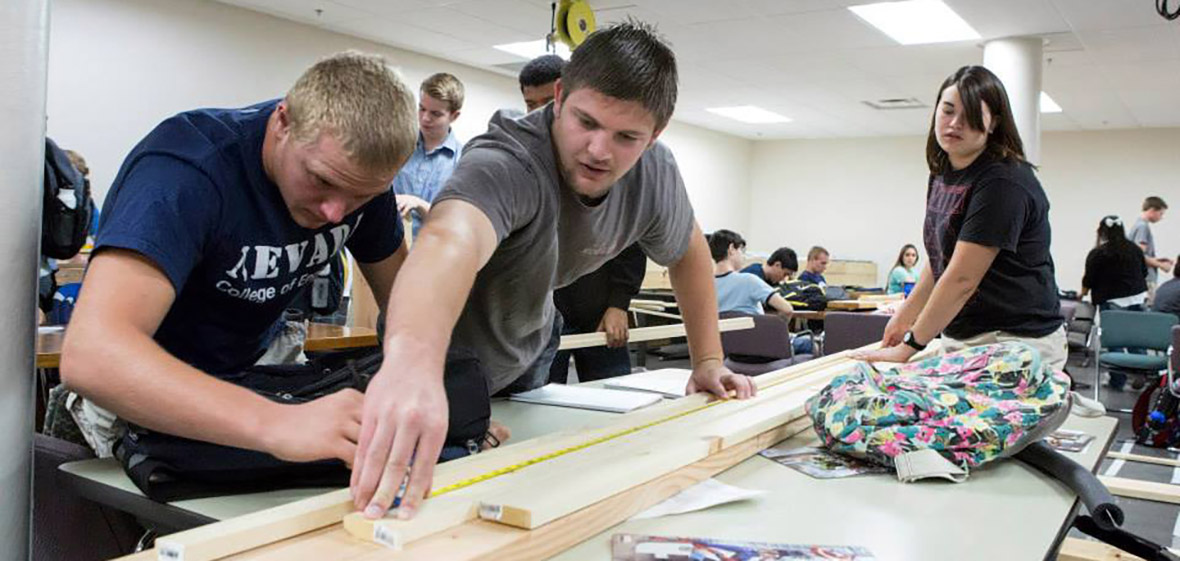The first "Campus Conversations" event of the semester focused on the theme of "Engagement."
And, those who attended the gathering in the Rotunda of the Mathewson-IGT Knowledge Center on Thursday afternoon - about 60 people as well as livestream audience throughout the state - were very much, in every way, "engaged."
The conversation was so productive, at one point Provost Kevin Carman, who was taking copious notes, said that, "I'm about at the end of my third page" of note-taking.
Moderated by Faculty Senate Chair Fred Harris and featuring both Carman and President Marc Johnson, those in attendance talked about a wide variety of engagement possibilities. A recurring point centered on the University's effort to become recognized as a Carnegie Community Engaged Institution. In spring 2019 the University will submit an application to the New England Resource Center for Higher Education to see if it meets the criteria for the Carnegie Community Engagement Classification.
Carnegie defines "Community Engagement" as the "collaboration between institutions of higher education and their larger communities (local, regional/state, national, global) for the mutually beneficial exchange of knowledge and resources in a context of partnership of reciprocity." Harris, along with Fred Holman, vice provost for extended studies, said there are about 74 institutions nationwide that have attained the classification, a figure that also includes 39 land-grant universities.
"So I guess the question is, how does that (classification) fit at UNR, and what does it mean?" Harris asked the audience.
Responses varied. Several faculty stressed a more specific process, through job performance evaluation and job expectation, to reward activities that would fall into the category of "engagement."
"We need to make it explicit that engagement will be valued," said Trudy Larson, director of the School of Community Health Sciences.
One of the acknowledged difficulties Thursday was faculty performance measures and evaluation are often based on teaching, research and service. Engagement activities can theoretically - and often in real life do - run through all three categories.
Drilling deeper into each of the categories, and finding ways for faculty to list engagement activities in each, said Holman, is a key piece in incentivizing engagement activity. "We have to have a systematic way to reward people who are doing it pedagogically, and through their research," he said.
Carman said that in general, engagement "needs to be not separate but infused as part of what we do." "We are already to a large extent doing this, though we aren't formally recognizing it," he said. "What we need to do is ask ourselves, 'Are we going to count these things as engagement, or are we going to go beyond?'"
Vice President for Research and Innovation Mridul Gautam added. He then cited numerous examples of how faculty had "gone beyond" simply checking a box for service, outreach or engagement by developing programs that had engaged the local Native American community, or had taken engineering projects into the community through summer camps and other hands-on activities. "These things go beyond what we typically do - they go beyond, and it helps us push ourselves to reach out to parts of the region which may not know about what the University can do for them."
Johnson said a critical form of engagement involved the student experience. He said that student internship programs with local businesses and agencies had earned "rave reviews" for the competency, usefulness and training the University's students had received. He agreed with many that engagement should not be considered a separate activity, and cited the work that students at the Nevada Autonomous Systems Innovation Center, which is housed in the University Innevation Center near downtown Reno, had done. The students, while working with research faculty, also are part of regular meetings with the local, regional and statewide business community.
"We have students learning from our researchers while engaging with the autonomous systems industry," he said. "It is all happening at the same time."
Associate Professor of Education Teruni Lamberg said the University, should always strive to listen to the community, asking the community, "What needs do you have?" She suggested a process of seeking out feedback from community stakeholders, one where the University engagement programs based on the feedback it had received.
Larson said her school had recently done just that, through a survey of 850 public health workers, in an effort to refine competencies that are taught and evaluate the effectiveness of her school's curriculum. "The people who tell you the skills they need are the people in the community," she said.
Donald W. Reynolds School of Journalism Dean Al Stavitsky cited several programs his school had initiated in order to engage with the community, and the state. Among them was a "Dance for Democracy" event that reached out to the local Hispanic community to demonstrate the caucus selection process for elections. The school has also launched Noticiero Movil, the School's first bilingual multimedia news program.
And yet, like many in the audience on Thursday, Stavitsky said it's not creative programming or committed faculty who are engaged that the University lacks. As the process moves forward in perhaps becoming a Carnegie Community Engaged institution, he said the biggest challenge remains one of measuring the totality of everyone's effort. "How do we capture the impact question?" he asked, noting that no matter what engagement is, or how it is defined, engagement runs through the teaching, scholarship and service that all faculty accomplish each year.











